This Pasta Pomodoro recipe is a go-to weeknight dinner that’s one of my family’s favorites! It’s sure to become a favorite with yours too.
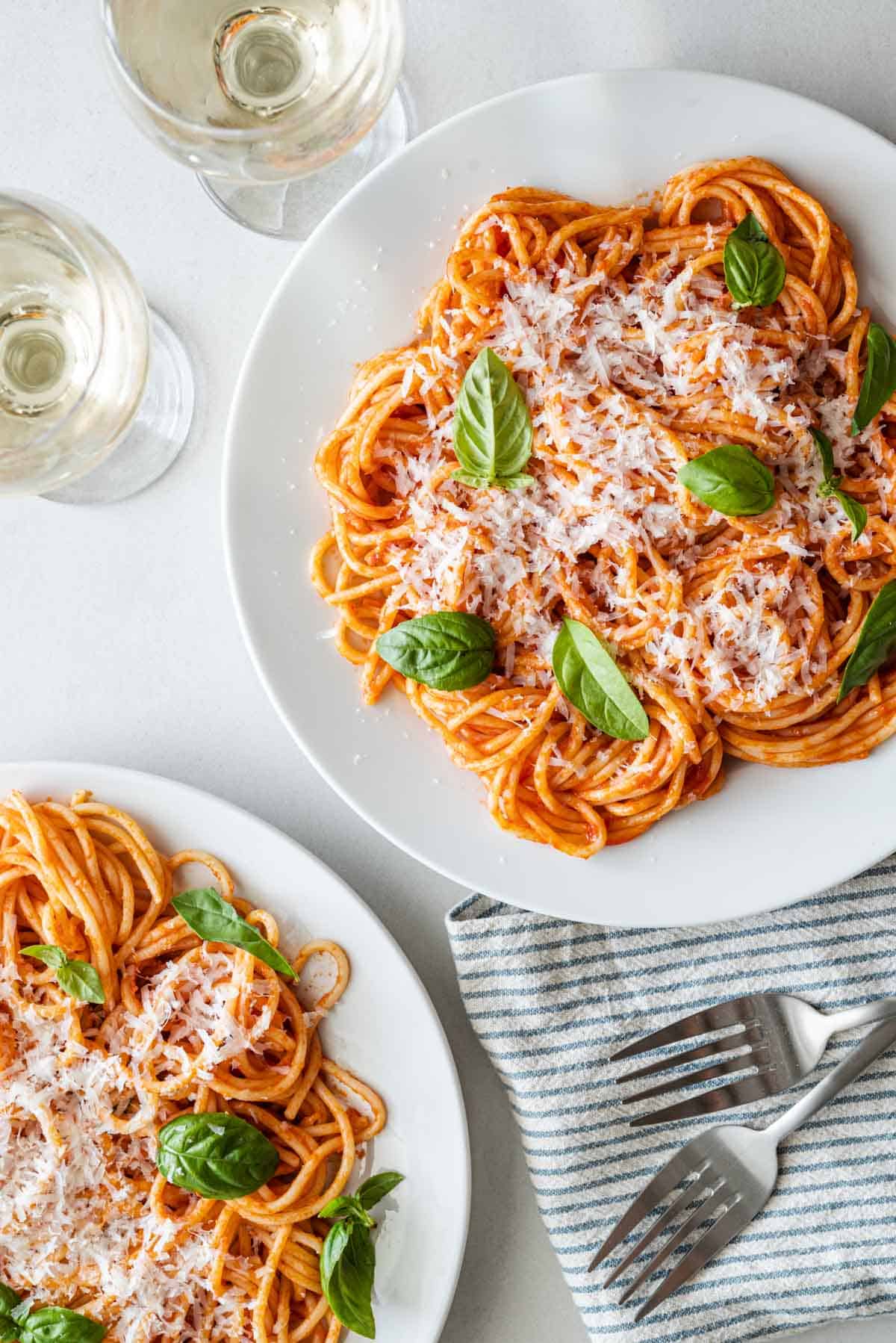
Italians pride themselves on their emphatically regional cuisine. But if a national dish did exist, it would be Pasta al Pomodoro, or Pasta al Pomodoro. It’s a simple yet delicious dish of spaghetti or rigatoni tossed with a rich, basil-infused tomato sauce. Is there anything better?
Spaghetti pomodoro is the first pasta dish I learned to make growing up. Compared with the other classic Italian recipes I’ve shared, like cacio e pepe or potato gnocchi, it’s essentially fail-proof–easy enough for the kids to make. It always brings me joy and satisfaction when I’m craving simple Italian comfort food.
If you’ve never made pomodoro pasta before you’ll be surprised at how quickly it comes together. Even better, you may never need to buy an expensive jar of sugary commercial tomato sauce again!
Table of Contents
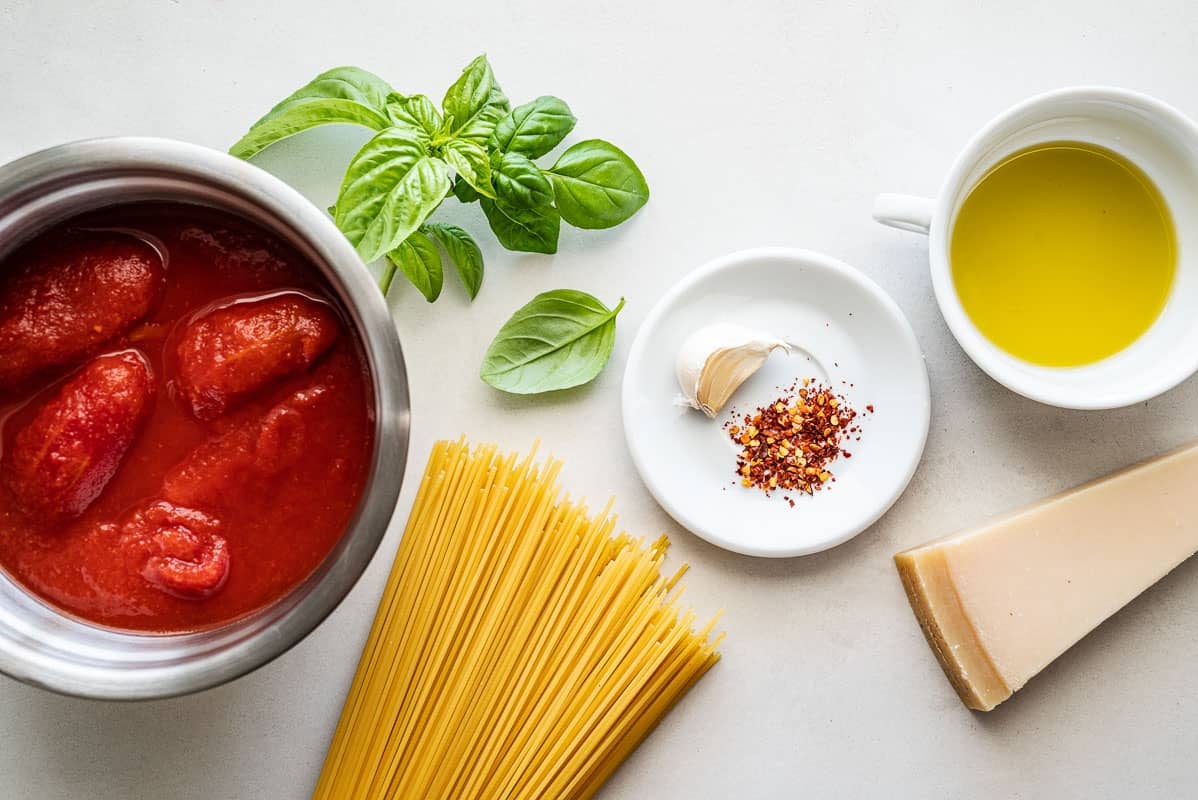
What is in Pasta Pomodoro
Ingredients for pasta al pomodoro vary from region to region and cook to cook. Some prefer their pomodoro sauce completely smooth, while others like a little texture. Some use garlic, others a chopped onion. I prefer a smooth sauce with crushed garlic, which infuses the olive oil with an irresistible flavor. To make it, you’ll need:
- Extra-virgin olive oil: Use a nice olive oil that tastes fresh and vibrant, like our
Italian Nocellara. - Garlic: One clove should be plenty. The garlic should be in harmony with the other ingredients, not the dominating flavor.
- Chili pepper (optional): In my family’s region of Abruzzo and in other southern regions, we often add chopped fresh hot pepper or a pinch of crushed red pepper flakes to our pomodoro sauce.
- Tip: If you love heat, try Penne Arrabbiata and Spaghetti all’Assassina next!
- Canned tomatoes: Look for whole peeled tomatoes packed in juice or light purée. Avoid cans whose ingredient lists show additions like sugar, diced peppers, or oregano.
- What about fresh tomatoes? Italians sometimes use fresh tomatoes when meaty sauce tomatoes, such as San Marzano or Roma, are in season. Most of the time, they (and I) prefer to use good-quality canned whole tomatoes or tomato passata (purée).
- Salt: Season with fine sea salt or kosher salt to taste.
- Basil: A branch (large sprig) of fresh basil or a handful of basil leaves perfumes the sauce with the herb’s sweet fragrance. Save some of the smaller, more delicate leaves for garnish if you’d like.
- Pasta: Spaghetti is the traditional choice for pasta pomodoro. However, plenty of shapes go well with this classic Italian sauce, like penne, rigatoni, potato gnocchi, and ricotta gnocchi.
- Parmesan cheese: Gives it that ultimate savory kick.
How to Make Pasta Pomodoro
For me, the best pomodoro sauces have a mellow and savory flavor with no hint of raw tomato, but not so cooked that it tastes like tomato paste. Here’s how to achieve that perfectly comforting and yet fresh taste:
Make the Pomodoro Sauce
- Soften the garlic: In a large saucepan over medium-low heat, warm 1/4 cup oil with 1 crushed garlic clove until it sizzles, about 2 minutes. Add a pinch of red pepper flakes and press on the garlic to release its flavor, but don’t let it brown. For a milder flavor, discard the garlic and keep the infused oil. Leave it in for a bolder taste.
- Add the tomatoes: Carefully pour in 1 (28-ounce) can whole peeled tomatoes and their juice. Use a potato masher or sturdy wooden spoon to break up the tomatoes into large pieces. Season with 1/2 teaspoon of salt and raise the heat to medium-high. Bring to a boil, then lower the heat to maintain a very gentle simmer.
- Simmer the sauce: Cover the pan partially and cook, stirring every now and then, until the tomatoes have darkened in color and the sauce has thickened, 35 to 40 minutes. The oil should be pooling on the surface. If the sauce thickens too much before it tastes sweeter and richer, add a splash of water.
- Process the sauce: Turn off the heat and let the sauce sit for 10 minutes to cool, then strain through a fine mesh strainer set over a bowl (you can also use a food mill if you’d like). Press the tomatoes through the strainer to make a smooth sauce, then return the sauce to the pan. Taste and add another pinch of salt, if needed.
- Season: Stir in the remaining 2 tablespoons of olive oil. Lay the branch of basil on top of the sauce and bring to a simmer over medium heat. Stir the sauce and cook gently for about 15 minutes. The basil will wilt into the sauce and infuse it with flavor. Turn off the heat and discard the branch of basil. Add a few more fresh basil leaves if you’d like. Cover the pan to keep the sauce warm.
Allow the Sauce to Rest while You Cook the Pasta
- Combine: Bring a large pot of water to a rolling boil and salt it generously. Drop in the pasta and cook according to the package instructions until just al dente. Use a pasta fork, tongs, or a skimmer to transfer the pasta directly to the pan with the sauce. Add a splash of the starchy pasta water and turn the heat under the pan on to low. Cook, tossing pasta and sauce together, for about 2 minutes, or until the noodles are cooked and well coated with the sauce.
- Serve: Divide the pasta between bowls and spoon any remaining sauce on top. Sprinkle with parmesan and basil and serve.
What to Serve with Pasta Pomodoro
One of the great features of pasta al pomodoro is that you can serve it as a main dish or in smaller portions as a primo piatto (first course).
- To serve as s a first course: Pair with a lighter protein, like grilled garlic-parmesan shrimp or chicken piccata meatballs.
- To serve as a main course: Pair with a simple salad, like lemon parmesan salad.
- For dessert? Try Torta di Carote (Italian Carrot Cake)
More Italian Pasta Recipes
Browse all Mediterranean recipes.
Visit Our Shop.
Pasta Pomodoro
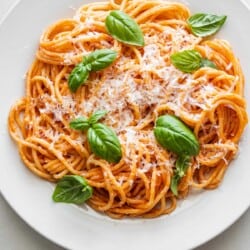
Ingredients
- 6 tablespoons extra virgin olive oil
- 1 garlic clove, lightly crushed and peeled
- 1 pinch red pepper flakes (optional)
- 1 (28-ounce) can whole peeled tomatoes
- Kosher salt
- 1 basil branch, plus more leaves for garnish
- 1 pound spaghetti (or packaged pasta of your choice)
- Freshly grated Parmesan cheese, for serving (optional)
Instructions
- Soften the garlic: In a large saucepan over medium-low heat, warm 1/4 cup oil with the garlic until it sizzles, about 2 minutes. Add a pinch of red pepper flakes and press the garlic to release its flavor, but don’t let it brown. For a milder flavor, discard the garlic and keep the infused oil. Leave it in for a bolder taste.
- Add the tomatoes: Carefully pour in the can of tomatoes and their juice. Use a potato masher or sturdy wooden spoon to break up the tomatoes into large pieces. Season with 1/2 teaspoon of salt and raise the heat to medium-high. Bring to a boil, then lower the heat to maintain a very gentle simmer.
- Simmer the sauce: Cover the pan partially and cook, stirring every now and then, until the tomatoes have darkened in color and the sauce has thickened, 35 to 40 minutes. The oil should be pooling on the surface. If the sauce thickens too much before it tastes sweeter and richer, add a splash of water.
- Process the sauce: Turn off the heat and let the sauce sit for 10 minutes to cool, then strain through a fine mesh strainer set over a bowl (you can also use a food mill if you’d like). Press the tomatoes through the strainer to make a smooth sauce, then return the sauce to the pan. Taste and add another pinch of salt, if needed.
- Season: Stir in the remaining 2 tablespoons of olive oil. Lay the branch of basil on top of the sauce and bring to a simmer over medium heat. Stir the sauce and cook gently for about 15 minutes. The basil will wilt into the sauce and infuse it with flavor. Turn off the heat and discard the branch of basil. Add a few more fresh basil leaves if you’d like. Cover the pan to keep the sauce warm.
- Combine: Bring a large pot of water to a rolling boil and salt it generously. Drop in the pasta and cook according to the package instructions until just al dente. Use a pasta fork, tongs, or a skimmer to transfer the pasta directly to the pan with the sauce. Add a splash of the starchy pasta water and turn the heat under the pan on to low. Cook, tossing pasta and sauce together, for about 2 minutes, or until the noodles are cooked and well coated with the sauce.
- Serve: Divide the pasta between bowls and spoon any remaining sauce on top. Sprinkle with Parmesan cheese (if using) and basil. Enjoy!
Notes
- Shop this recipe: Visit our shop to browse quality Mediterranean ingredients, including the olive oil and spaghetti used in this recipe.
- Which canned tomatoes to use? Many swear by true San Marzanos, which are grown in volcanic soil near Naples and carry a D.O.P. seal to certify their origin. Most tomatoes labeled ‘San Marzano’ are actually grown elsewhere; some are nearly–if not just as good–and more affordable. Whatever the label, the best test is always taste. Look for a fresh, vibrant tomato flavor.
- If your pan isn’t large enough to hold the pasta and the sauce:
- Set aside about 1 cup of the starchy pasta water before draining.
- Return the drained pasta to the pot and spoon in half to 2/3 of sauce, along with a splash of cooking water.
- Toss the hot pasta and sauce together over low heat until the pasta is well coated. Add a splash of reserved cooking water to loosen the sauce if needed.
- Pomodoro sauce gets even more vibrant overnight! If you have the time, make the sauce a day in advance (wait to combine it with the pasta). Store sealed in the refrigerator, and then reheat it gently on the stove just before serving.
- To freeze: Allow the sauce to cool, then transfer to a freezer-safe container (leave room at the top for expansion). Freeze for up to 3 months. Thaw in the refrigerator overnight, or on your counter for a few hours.
- If you prefer a sauce with texture, you can skip the milling or straining. Simply use a potato masher to break down any large pieces.
Nutrition

Try Our Authentic Italian Olive Oil
Hand-picked and cold-extracted Extra Virgin Olive Oil from 100% Nocellara del Belice Sicilian olives.
*This post has recently been updated with new information for the readers’ benefit.

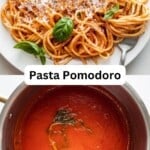

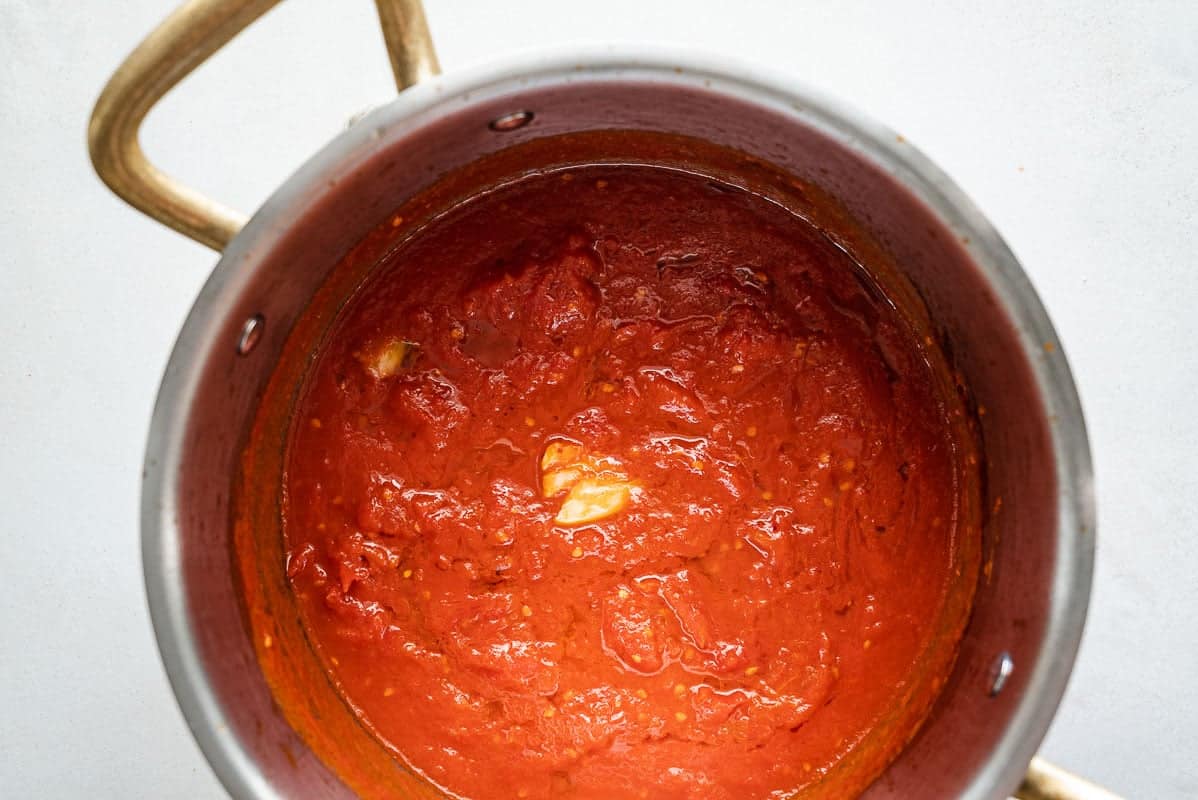
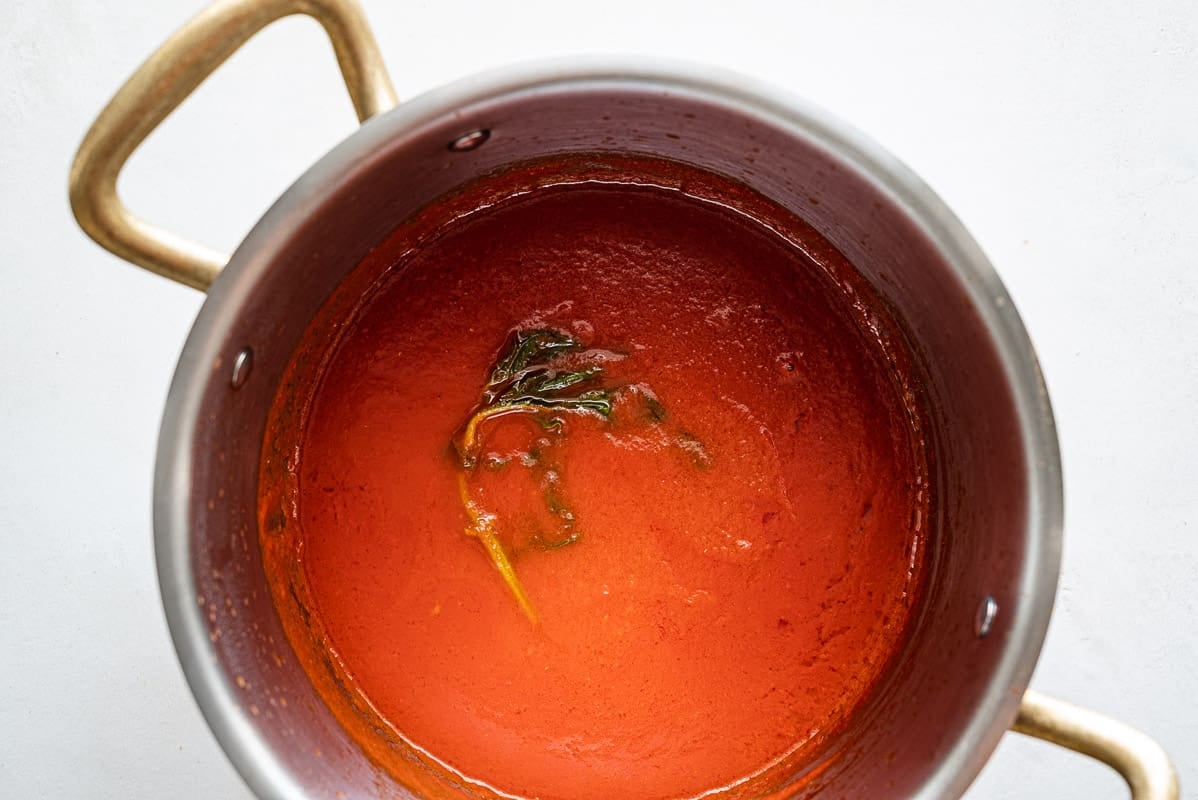
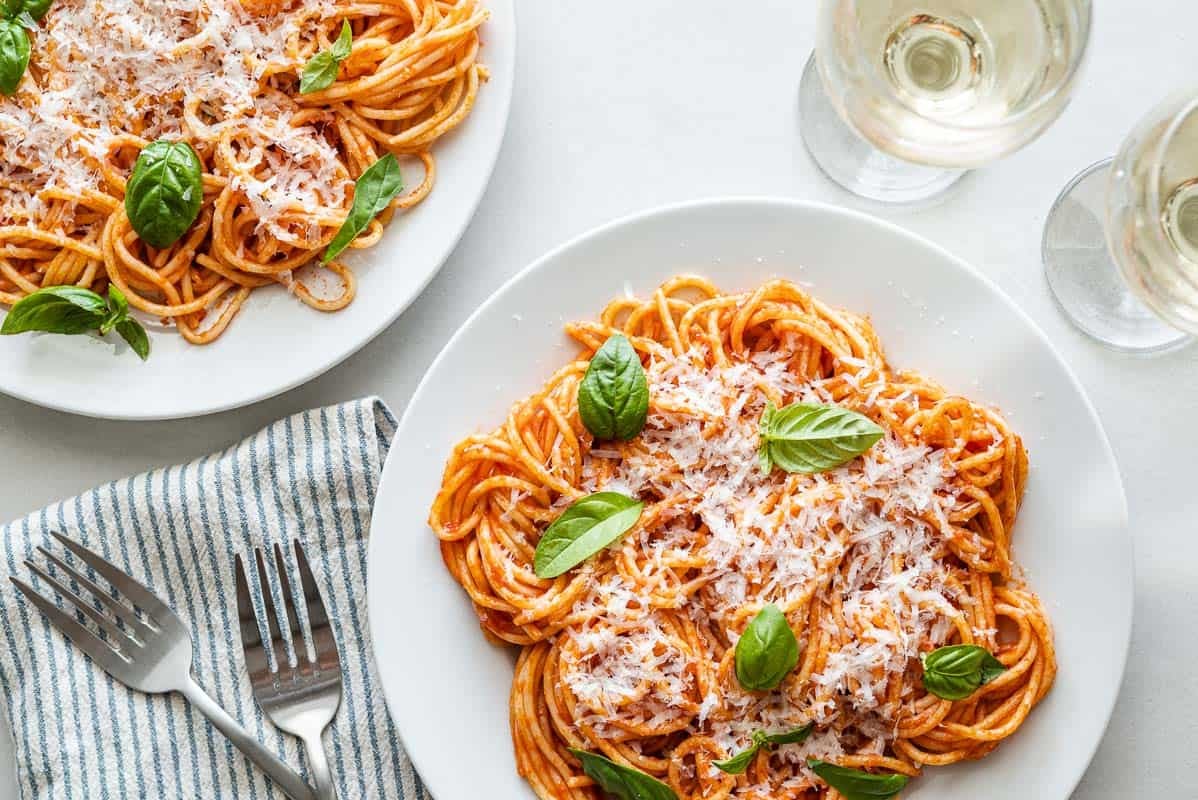
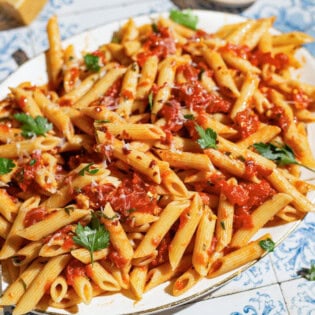

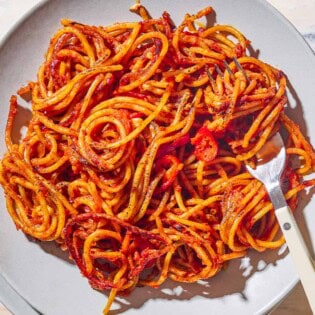
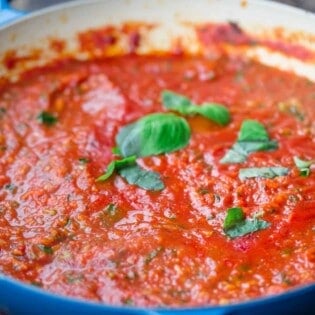
Simply the best!
Can you use fresh tomatoes? And if so, how much (weight) – the same as the can states or more?
Love your emails and recipes!
This sounds magical. Going to make it tonight. I do have a question regarding the calories. I have read and re-read the ingredients. How can it have such a high calorie count? 625? No it won’t stop us from making, eating and enjoying the dish. Thanks.
Hi, Katherine. I went back and checked the nutritional calculations here, and it looks like the pasta that contributes the most to the calorie count. This recipe serves 4, so one serving would be pretty generous. You could also reduce the amount, and add a nice salad or some steamed/roasted veggies on the side.
6T of olive oil is 714 calories
sounds great and FRESH tasting!
my question is what kind of pan is it that you’re using with a stainless body and brass handles?
Totally delicious. Amazingly cost effective. As usual another winning Susie recipe. They never disappoint, always extremely well described. Such a joy to cook.
Thank you so much, Heather!
Yummy
Not just a tomato sauce! It was absolutely delicious 😋
Thanks so much, Sally!
I have no doubt this is good, but my idea of the Basic Tomato Sauce is: throw a tin of diced tomatoes into the pan; when warm, mix in some BUTTER, not oil, and stir well; add an onion cut in two or four; when cooked, discard the onion and add salt and pepper.
I hope you do give this one a try, even if you have your own recipe you enjoy! It’s a good one!
Delicious! Easy! and a nice base to use with other sauce recipes. Highly recommend. FOR SURE double the recipe – you won’t regret having extra. 🙂
I agree! Thanks, Eileen!
I haven’t tried it yet but it looks so yummy. Having guests this week and now I know my menu.
Simple. Always the best. I would sauté an onion and mushrooms for the sauce too. Extra mushrooms and onion mixture, add chicken thighs and sauté. I always like to have protein. Very simple, quick, delicious and nutritious meal. Mangia!
I have never heard of a basil branch. How much basil is that?
Hi, Tanja. It’s basically one stem of basil that holds about a handful of leaves. You don’t have to be super precise here. This recipe is very forgiving.